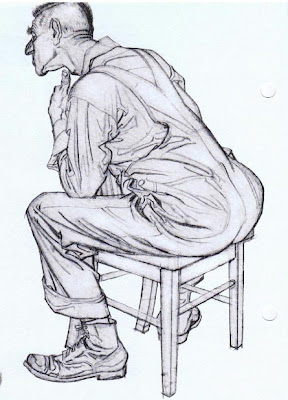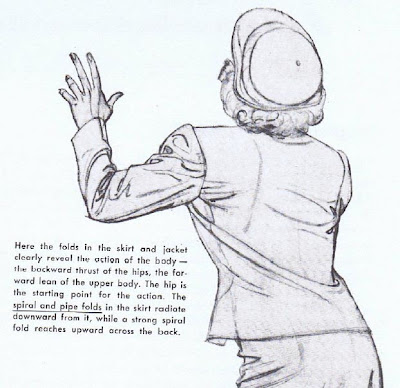
“Note the way the overalls are bunched into deep half-lock folds in the back of the knee and at the hip joint. On the buttocks, the top of the thigh and the knee, the material stretches tightly over the underlying forms.”
I would add a couple more observations. The folds radiate from points of tension (shoulder, butt, knee, and elbow). Since most modern, fitted garments are constructed to be relatively wrinkle-free for a standing figure, a seated or kneeling figure creates areas of compression where the material has no choice but bunch up.

Folds also radiate from the seams where the arms meet the shoulders on both of these figures. Those folds often don’t continue across the seam because of the contrasts in thickness and fabric grain direction from one side of the seam to another.
All of these effects are softened in knit fabrics (such as T-shirts), which stretch in all directions, as opposed to woven fabrics, which stretch only on the bias.
-------
Famous Artist's School on Wikipedia







15 comments:
Thanks for this post.
I had to look up "on the bias," but it makes sense now.
http://sewing.about.com/od/beginner1/p/fabricgrain.htm
Knowledge of draping is one of the things most sorely lacking in much of today's art, particularly in comics. Look at any comic from the 40's or 50's and almost every artist could drape a suit or a dress. The guys who know it today know it well, but 75% just fake their way through it.
Hmm... Yesterday, when I was trying to get asleep in bed, I was (beside of counting sheep) thinking of how wrinkels work, and that I should start studying those things.
And today, tadaaa...: a GurneyJourney blogpost about wrinkles :-).
A reminder to J. Gurney: this night I'll think in bed about the different types of (cross)hatching and other methods of rendering an image using lines. ;-)
great!!!
I alweys have troubles drawing draperies... they always look "standarized", and as I see, mr. Dorne has a huuuge experience in reality observation... envy... XD
thanks for this culture. I love your blog!
I agree with Joe Jusko about drapery skills in today's illustration. I try to do my part in keeping the academic tradition alive with the students I teach.
Dorne was such a great draftsman. I browse his work again and again in my FA School books.
Bridgeman's drapery book is pretty helpful. Its really important to understand when doing a clothed figure because like the hair - it is never the same when the model breaks the pose - no matter how much tape you put down :)
One of these days i have to try doing a study of a cloth dipped in plaster of paris, since i have recommended doing just that to so many artists :)
Really nice examples.
You can never say enough about folds- theyre so complex and even the untrained eye can see when theyre done right and when theyre done wrong. Remarkable.
The extraordinarily talented John Watkiss has wonderful little booklet on garment construction that I have found to be extremely helpful. I was able to purchase it directly from him.
A link can be found to it here.
When I think back on how a couple of friends and I used to goof on the Famous Artists' School ads (matchbooks and the like)...We didn't have a clue that it was really the source of some useful instruction. Case in point.
Would you recommend the book "Dynamic Wrinkles" by Burne Hogarth for those who seek more insight in the patterns of wrinkles in clothing?
Johan, I am no James Gurney but I would NOT recommand dynamic drapery by Hogarth .To me the most helpful lesson I had was (as often) the Vilppu video on drapery. you can also see his classification of the "seven basic folds" in the Famous Artist Course (chap 7). I found it quite useful to name the different type of folds before you draw them. But I guess the problem is that we all look for a magical method to draw quickly something that is almost as complicated as the human body (which, has only one type of skin, when there is so many different type of fabrics in clothes). I am not either a specialist of folds (if you check out my blog i'm affraid you'll see that) but one useful tip is : look for the seam and draw volumes for wrinkles, not lines (the side of the pencil is more efficient in that case). And whenever you can, try to emphasize the roundness of form underneath the clothes.
Just as an anatomy book isn't all it takes to become good at figure drawing, I guess the best way to learn drapery is to draw from life. A lot.
Great post.
Johan -- Gleaning knowledge from Hogarth books is a skill unto itself. His drawings are schematics that explain his ideas -- but he is explaining everything all at once -- like the whole drawing is turned up to eleven. I think he has some sound organizational ideas on a complex subject that might help your thought process -- but as others have said, you can't beat drawing and observing from life.
Joe Jusko -- agreed.
But I wonder if the lack of wrinkles in today's art is related to the rise of knit fabrics? I hadn't put those two thoughts together until this blog post -- (thanks Jim). In the 40s and 50s you could look over at the guy next to you and he'd be wearing a wool suit -- today even the Jeans have spandex!
Yes, drawing from life is always the best solution, but still, books are available for purchase, hence the question (is it worth the money and worth the time studying it's content) :)
Thanks all for your advise.
Let's draw!
Post a Comment